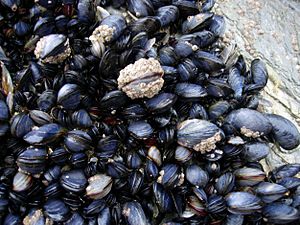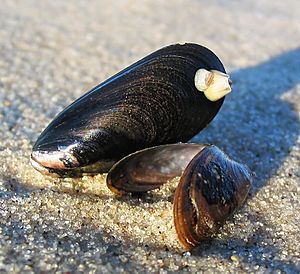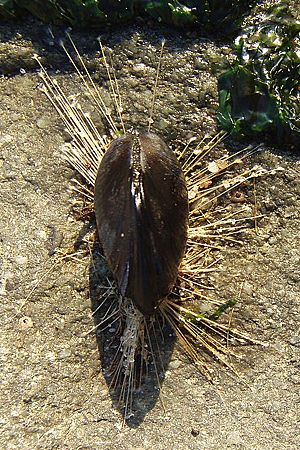Mytilus (bivalve) facts for kids
Quick facts for kids Mytilus |
|
|---|---|
 |
|
| Mytilus edulis in the intertidal zone in Cornwall, England | |
| Scientific classification |
|
| Kingdom: | Animalia |
| Phylum: | Mollusca |
| Class: | Bivalvia |
| Order: | Mytilida |
| Family: | Mytilidae |
| Subfamily: | Mytilinae |
| Genus: | Mytilus Linnaeus, 1758 |
| Type species | |
| Mytilus edulis Linnaeus, 1758
|
|
| Species | |
|
See text |
|

Mytilus is a group of medium to large-sized mussels. These are ocean animals that live in saltwater. They are a type of bivalve mollusc, which means they have two shells. You can find Mytilus mussels all over the world. They belong to the Mytilidae family.
Contents
What Mussels Look Like
Mussels usually have shells that are gray to blue-purple. When they are fully grown, their shells are about 5 to 10 centimeters long. The shells have an oval shape that is a bit stretched out.
A mussel's shell has two halves, a right and a left side. These halves are held together by a stretchy band called a ligament. The shell itself is made of three layers. The outside layer is made of an organic material. The middle layer is thick and made of lime. The inside layer is shiny, silver-white, and called mother-of-pearl.
Inside the mussel's shell, you will find two gills. These gills have many blood vessels. Mussels also have a muscular foot. This foot has a special gland that makes byssus threads. These threads are made from protein and iron from the sea. Mussels use these strong threads to hold onto things. This helps them stay in place. Mussels also have other body parts like a heart, stomach, intestines, and kidneys. They have a muscle that lets them close their shells tightly if they are in danger or if the water goes away.
Types of Mussels
The Mytilus group includes several different types of mussels. Some of the well-known species are:
- Mytilus californianus - This is also known as the California mussel.
- Mytilus coruscus
- The Mytilus edulis group, which includes several similar types:
- Mytilus edulis - Often called the blue mussel or edible blue mussel.
- Mytilus galloprovincialis - Known as the Mediterranean mussel.
- Mytilus planulatus - This is the Australian blue mussel.
- Mytilus platensis
- Mytilus chilensis - Also called the Chilean blue mussel.
- Mytilus trossulus - Sometimes called the foolish mussel.
Scientists have also found many fossil mussels from this group. The oldest ones date back to the Triassic period.
How Mussels Eat
Mussels are filter feeders. This means they get their food by filtering water. They have two openings in their bodies. Water flows into the mussel through one opening. Tiny hairs inside the mussel create a constant water flow.
As the water moves through, small food particles stick to a sticky layer on the gills. These food particles are mostly tiny plants and animals called plankton. The tiny hairs then move the food and mucus to the mussel's mouth. From there, the food goes into the stomach and intestines to be digested. Any parts that the mussel cannot digest are pushed out through the other opening with the water.
Mussel Reproduction and Life Cycle
Every spring and summer, female mussels release millions of eggs. Males then fertilize these eggs. The fertilized eggs grow into tiny larvae. Most of these larvae are eaten by other animals during their four-week development. However, many young mussels still survive.
These young mussels are about three millimeters long. They often float in the sea for hundreds of kilometers. After about four weeks, they attach themselves to rocks, poles, sand, or other mussels using their byssus threads. They often prefer to live in brackish water, which is a mix of fresh and saltwater, found in estuaries and mud flats along coastlines.
Mussels often live in very large groups called colonies or banks. Living together in large numbers helps the males have a better chance of fertilizing eggs.
Mussels and Humans
People around the world use Mytilus mussels as food. They are also raised on farms in the sea, which is called mariculture. For example, in California, Native American people have been eating these mussels for almost 12,000 years.
Scientists have also found special substances in some Mytilus mussels. These substances, called Mytilin A and B, can help fight germs.
See also
 In Spanish: Mytilus para niños
In Spanish: Mytilus para niños


